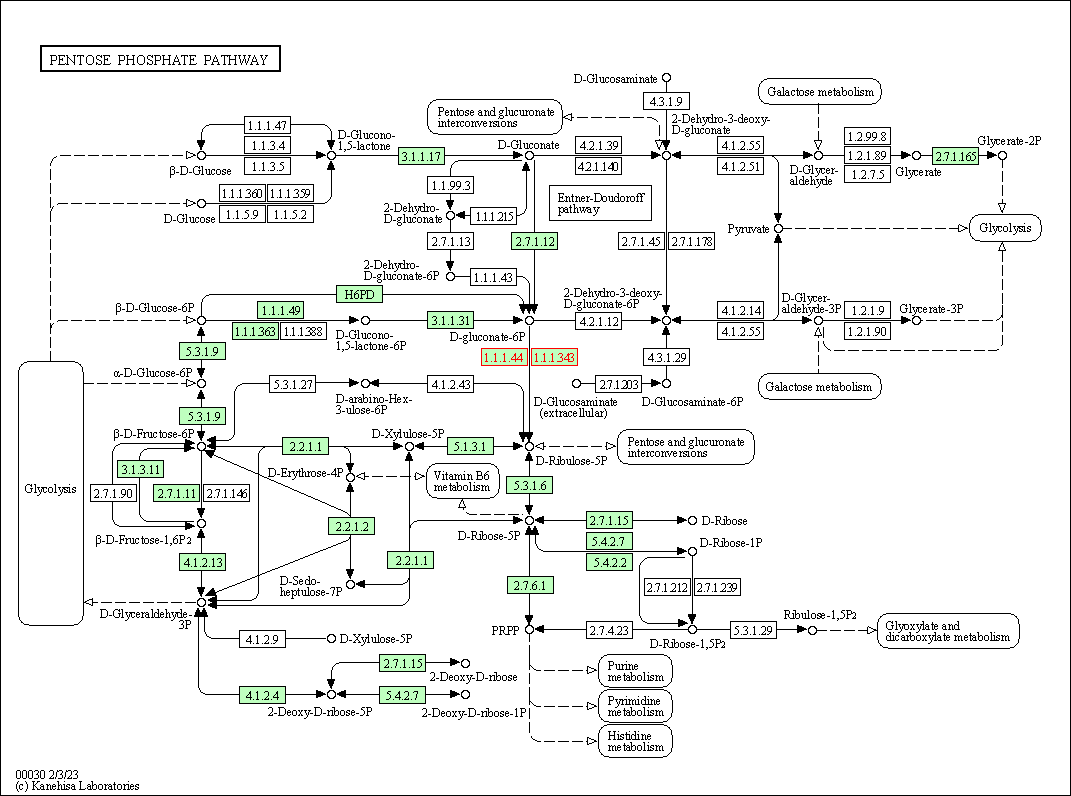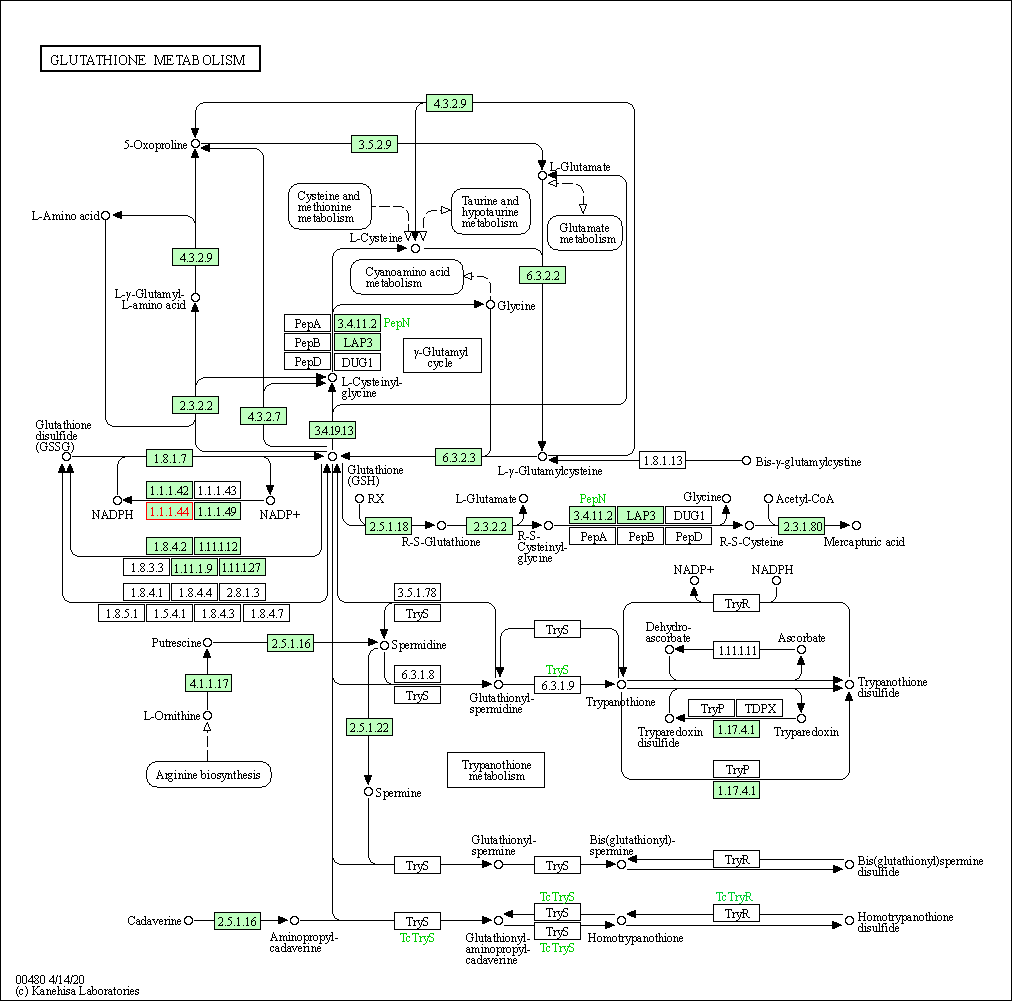Target Information
| Target General Information | Top | |||||
|---|---|---|---|---|---|---|
| Target ID |
T76497
(Former ID: TTDR00910)
|
|||||
| Target Name |
Phosphogluconate dehydrogenase (PGD)
|
|||||
| Synonyms |
PGDH; 6PGDH; 6-phosphogluconate dehydrogenase, decarboxylating; 6-phosphogluconate dehydrogenase
Click to Show/Hide
|
|||||
| Gene Name |
PGD
|
|||||
| Target Type |
Successful target
|
[1] | ||||
| Disease | [+] 1 Target-related Diseases | + | ||||
| 1 | Pituitary gland disorder [ICD-11: 5A60-5A61] | |||||
| Function |
Catalyzes the oxidative decarboxylation of 6-phosphogluconate to ribulose 5-phosphate and CO(2), with concomitant reduction of NADP to NADPH.
Click to Show/Hide
|
|||||
| BioChemical Class |
CH-OH donor oxidoreductase
|
|||||
| UniProt ID | ||||||
| EC Number |
EC 1.1.1.44
|
|||||
| Sequence |
MAQADIALIGLAVMGQNLILNMNDHGFVVCAFNRTVSKVDDFLANEAKGTKVVGAQSLKE
MVSKLKKPRRIILLVKAGQAVDDFIEKLVPLLDTGDIIIDGGNSEYRDTTRRCRDLKAKG ILFVGSGVSGGEEGARYGPSLMPGGNKEAWPHIKTIFQGIAAKVGTGEPCCDWVGDEGAG HFVKMVHNGIEYGDMQLICEAYHLMKDVLGMAQDEMAQAFEDWNKTELDSFLIEITANIL KFQDTDGKHLLPKIRDSAGQKGTGKWTAISALEYGVPVTLIGEAVFARCLSSLKDERIQA SKKLKGPQKFQFDGDKKSFLEDIRKALYASKIISYAQGFMLLRQAATEFGWTLNYGGIAL MWRGGCIIRSVFLGKIKDAFDRNPELQNLLLDDFFKSAVENCQDSWRRAVSTGVQAGIPM PCFTTALSFYDGYRHEMLPASLIQAQRDYFGAHTYELLAKPGQFIHTNWTGHGGTVSSSS YNA Click to Show/Hide
|
|||||
| 3D Structure | Click to Show 3D Structure of This Target | PDB | ||||
| HIT2.0 ID | T97UTI | |||||
| Drugs and Modes of Action | Top | |||||
|---|---|---|---|---|---|---|
| Approved Drug(s) | [+] 1 Approved Drugs | + | ||||
| 1 | GHRP-2 | Drug Info | Approved | Growth hormone deficiency | [2] | |
| Mode of Action | [+] 1 Modes of Action | + | ||||
| Inhibitor | [+] 6 Inhibitor drugs | + | ||||
| 1 | GHRP-2 | Drug Info | [1] | |||
| 2 | (2R)-2-Methyl-4,5-dideoxy | Drug Info | [1] | |||
| 3 | 4-phospho-D-erythronate | Drug Info | [3] | |||
| 4 | 5-deoxy-5-phosphono-D-arabinonate | Drug Info | [4] | |||
| 5 | 6-Phosphogluconic Acid | Drug Info | [5] | |||
| 6 | Pyrophosphate 2- | Drug Info | [6] | |||
| Cell-based Target Expression Variations | Top | |||||
|---|---|---|---|---|---|---|
| Cell-based Target Expression Variations | ||||||
| Drug Binding Sites of Target | Top | |||||
|---|---|---|---|---|---|---|
| Ligand Name: 3-Phosphoglyceric Acid | Ligand Info | |||||
| Structure Description | Crystal structure of 6-phosphogluconate dehydrogenase complexed with 3-phosphoglyceric acid | PDB:4GWK | ||||
| Method | X-ray diffraction | Resolution | 1.53 Å | Mutation | No | [7] |
| PDB Sequence |
AQADIALIGL
11 AVMGQNLILN21 MNDHGFVVCA31 FNRTVSKVDD41 FLANEAKGTK51 VVGAQSLKEM 61 VSKLKKPRRI71 ILLVKAGQAV81 DDFIEKLVPL91 LDTGDIIIDG101 GNSEYRDTTR 111 RCRDLKAKGI121 LFVGSGVSGG131 EEGARYGPSL141 MPGGNKEAWP151 HIKTIFQGIA 161 AKVGTGEPCC171 DWVGDEGAGH181 FVKMVHNGIE191 YGDMQLICEA201 YHLMKDVLGM 211 AQDEMAQAFE221 DWNKTELDSF231 LIEITANILK241 FQDTDGKHLL251 PKIRDSAGQK 261 GTGKWTAISA271 LEYGVPVTLI281 GEAVFARCLS291 SLKDERIQAS301 KKLKGPFQFD 313 GDKKSFLEDI323 RKALYASKII333 SYAQGFMLLR343 QAATEFGWTL353 NYGGIALMWR 363 GGCIIRSVFL373 GKIKDAFDRN383 PELQNLLLDD393 FFKSAVENCQ403 DSWRRAVSTG 413 VQAGIPMPCF423 TTALSFYDGY433 RHEMLPASLI443 QAQRDYFGAH453 TYELLAKPGQ 463 FIHTNWT
|
|||||
|
|
||||||
| Ligand Name: NADP+ | Ligand Info | |||||
| Structure Description | Structure of human Phosphogluconate Dehydrogenase in complex with NADPH at 2.53A | PDB:2JKV | ||||
| Method | X-ray diffraction | Resolution | 2.53 Å | Mutation | No | [8] |
| PDB Sequence |
AQADIALIGL
11 AVMGQNLILN21 MNDHGFVVCA31 FNRTVSKVDD41 FLANEAKGTK51 VVGAQSLKEM 61 VSKLKKPRRI71 ILLVKAGQAV81 DDFIEKLVPL91 LDTGDIIIDG101 GNSEYRDTTR 111 RCRDLKAKGI121 LFVGSGVSGG131 EEGARYGPSL141 MPGGNKEAWP151 HIKTIFQGIA 161 AKVGTGEPCC171 DWVGDEGAGH181 FVKMVHNGIE191 YGDMQLICEA201 YHLMKDVLGM 211 AQDEMAQAFE221 DWNKTELDSF231 LIEITANILK241 FQDTDGKHLL251 PKIRDSAGQK 261 GTGKWTAISA271 LEYGVPVTLI281 GEAVFARCLS291 SLKDERIQAS301 KKLKGPQKFQ 311 FDGDKKSFLE321 DIRKALYASK331 IISYAQGFML341 LRQAATEFGW351 TLNYGGIALM 361 WRGGCIIRSV371 FLGKIKDAFD381 RNPELQNLLL391 DDFFKSAVEN401 CQDSWRRAVS 411 TGVQAGIPMP421 CFTTALSFYD431 GYRHEMLPAS441 LIQAQRDYFG451 AHTYELLAKP 461 GQFIHTNWTG471 HGGTVSSSSY481 NA
|
|||||
|
|
||||||
| Click to View More Binding Site Information of This Target with Different Ligands | ||||||
| Different Human System Profiles of Target | Top |
|---|---|
|
Human Similarity Proteins
of target is determined by comparing the sequence similarity of all human proteins with the target based on BLAST. The similarity proteins for a target are defined as the proteins with E-value < 0.005 and outside the protein families of the target.
A target that has fewer human similarity proteins outside its family is commonly regarded to possess a greater capacity to avoid undesired interactions and thus increase the possibility of finding successful drugs
(Brief Bioinform, 21: 649-662, 2020).
Human Tissue Distribution
of target is determined from a proteomics study that quantified more than 12,000 genes across 32 normal human tissues. Tissue Specificity (TS) score was used to define the enrichment of target across tissues.
The distribution of targets among different tissues or organs need to be taken into consideration when assessing the target druggability, as it is generally accepted that the wider the target distribution, the greater the concern over potential adverse effects
(Nat Rev Drug Discov, 20: 64-81, 2021).
Human Pathway Affiliation
of target is determined by the life-essential pathways provided on KEGG database. The target-affiliated pathways were defined based on the following two criteria (a) the pathways of the studied target should be life-essential for both healthy individuals and patients, and (b) the studied target should occupy an upstream position in the pathways and therefore had the ability to regulate biological function.
Targets involved in a fewer pathways have greater likelihood to be successfully developed, while those associated with more human pathways increase the chance of undesirable interferences with other human processes
(Pharmacol Rev, 58: 259-279, 2006).
Biological Network Descriptors
of target is determined based on a human protein-protein interactions (PPI) network consisting of 9,309 proteins and 52,713 PPIs, which were with a high confidence score of ≥ 0.95 collected from STRING database.
The network properties of targets based on protein-protein interactions (PPIs) have been widely adopted for the assessment of target’s druggability. Proteins with high node degree tend to have a high impact on network function through multiple interactions, while proteins with high betweenness centrality are regarded to be central for communication in interaction networks and regulate the flow of signaling information
(Front Pharmacol, 9, 1245, 2018;
Curr Opin Struct Biol. 44:134-142, 2017).
Human Similarity Proteins
Human Tissue Distribution
Human Pathway Affiliation
Biological Network Descriptors
|
|
|
There is no similarity protein (E value < 0.005) for this target
|
|
Note:
If a protein has TS (tissue specficity) scores at least in one tissue >= 2.5, this protein is called tissue-enriched (including tissue-enriched-but-not-specific and tissue-specific). In the plots, the vertical lines are at thresholds 2.5 and 4.
|
| KEGG Pathway | Pathway ID | Affiliated Target | Pathway Map |
|---|---|---|---|
| Pentose phosphate pathway | hsa00030 | Affiliated Target |

|
| Class: Metabolism => Carbohydrate metabolism | Pathway Hierarchy | ||
| Glutathione metabolism | hsa00480 | Affiliated Target |

|
| Class: Metabolism => Metabolism of other amino acids | Pathway Hierarchy | ||
| Degree | 9 | Degree centrality | 9.67E-04 | Betweenness centrality | 2.18E-04 |
|---|---|---|---|---|---|
| Closeness centrality | 1.89E-01 | Radiality | 1.32E+01 | Clustering coefficient | 3.61E-01 |
| Neighborhood connectivity | 9.89E+00 | Topological coefficient | 2.67E-01 | Eccentricity | 13 |
| Download | Click to Download the Full PPI Network of This Target | ||||
| Chemical Structure based Activity Landscape of Target | Top |
|---|---|
| Drug Property Profile of Target | Top | |
|---|---|---|
| (1) Molecular Weight (mw) based Drug Clustering | (2) Octanol/Water Partition Coefficient (xlogp) based Drug Clustering | |
|
|
||
| (3) Hydrogen Bond Donor Count (hbonddonor) based Drug Clustering | (4) Hydrogen Bond Acceptor Count (hbondacc) based Drug Clustering | |
|
|
||
| (5) Rotatable Bond Count (rotbonds) based Drug Clustering | (6) Topological Polar Surface Area (polararea) based Drug Clustering | |
|
|
||
| "RO5" indicates the cutoff set by lipinski's rule of five; "D123AB" colored in GREEN denotes the no violation of any cutoff in lipinski's rule of five; "D123AB" colored in PURPLE refers to the violation of only one cutoff in lipinski's rule of five; "D123AB" colored in BLACK represents the violation of more than one cutoffs in lipinski's rule of five | ||
| Target Poor or Non Binders | Top | |||||
|---|---|---|---|---|---|---|
| Target Poor or Non Binders | ||||||
| Target Regulators | Top | |||||
|---|---|---|---|---|---|---|
| Target-regulating microRNAs | ||||||
| Target Affiliated Biological Pathways | Top | |||||
|---|---|---|---|---|---|---|
| BioCyc | [+] 2 BioCyc Pathways | + | ||||
| 1 | Pentose phosphate pathway | |||||
| 2 | Pentose phosphate pathway (oxidative branch) | |||||
| KEGG Pathway | [+] 5 KEGG Pathways | + | ||||
| 1 | Pentose phosphate pathway | |||||
| 2 | Glutathione metabolism | |||||
| 3 | Metabolic pathways | |||||
| 4 | Biosynthesis of antibiotics | |||||
| 5 | Carbon metabolism | |||||
| Panther Pathway | [+] 1 Panther Pathways | + | ||||
| 1 | Pentose phosphate pathway | |||||
| Pathwhiz Pathway | [+] 1 Pathwhiz Pathways | + | ||||
| 1 | Warburg Effect | |||||
| WikiPathways | [+] 4 WikiPathways | + | ||||
| 1 | NRF2 pathway | |||||
| 2 | Nuclear Receptors Meta-Pathway | |||||
| 3 | Metabolism of carbohydrates | |||||
| 4 | Pentose Phosphate Pathway | |||||
| Target-Related Models and Studies | Top | |||||
|---|---|---|---|---|---|---|
| Target Validation | ||||||
| References | Top | |||||
|---|---|---|---|---|---|---|
| REF 1 | Synthesis and biological evaluation of substrate-based inhibitors of 6-phosphogluconate dehydrogenase as potential drugs against African trypanosomiasis. Bioorg Med Chem. 2003 Jul 17;11(14):3205-14. | |||||
| REF 2 | Drugs@FDA. U.S. Food and Drug Administration. U.S. Department of Health & Human Services. 2015 | |||||
| REF 3 | Virtual fragment screening for novel inhibitors of 6-phosphogluconate dehydrogenase. Bioorg Med Chem. 2010 Jul 15;18(14):5056-62. | |||||
| REF 4 | Sugar derivatives as new 6-phosphogluconate dehydrogenase inhibitors selective for the parasite Trypanosoma brucei. Bioorg Med Chem. 2003 Apr 3;11(7):1207-14. | |||||
| REF 5 | How many drug targets are there Nat Rev Drug Discov. 2006 Dec;5(12):993-6. | |||||
| REF 6 | The Protein Data Bank. Nucleic Acids Res. 2000 Jan 1;28(1):235-42. | |||||
| REF 7 | Phosphoglycerate mutase 1 coordinates glycolysis and biosynthesis to promote tumor growth. Cancer Cell. 2012 Nov 13;22(5):585-600. | |||||
| REF 8 | Structure of Human Phosphogluconate Dehydrogenase in Complex with Nadph at 2.53A | |||||
If You Find Any Error in Data or Bug in Web Service, Please Kindly Report It to Dr. Zhou and Dr. Zhang.

